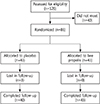1. Kannan P, Chapple CM, Miller D, Claydon LS, Baxter GD. Menstrual pain and quality of life in women with primary dysmenorrhea: rationale, design, and interventions of a randomized controlled trial of effects of a treadmill-based exercise intervention. Contemp Clin Trials. 2015; 42:81–89.

2. Chen HM, Chen CH. Effects of acupressure on menstrual distress in adolescent girls: a comparison between Hegu-Sanyinjiao matched points and Hegu, Zusanli single point. J Clin Nurs. 2010; 19:998–1007.

3. Meda A, Lamien CE, Millogo J, Romito M, Nacoulma OG. Therapeutic uses of honey and honeybee larvae in central Burkina Faso. J Ethnopharmacol. 2004; 95:103–107.

4. Potharaju J, Usha P. Prevalence of primary dysmenorrhea in young women-an institutional study. J Evol Med Dent Sci. 2017; 6:6948–6951.
5. Jenabi E, Fereidoony B. Effect of Achillea millefolium on relief of primary dysmenorrhea: a double-blind randomized clinical trial. J Pediatr Adolesc Gynecol. 2015; 28:402–404.

6. Dmitrovic R, Kunselman AR, Legro RS. Sildenafil citrate in the treatment of pain in primary dysmenorrhea: a randomized controlled trial. Hum Reprod. 2013; 28:2958–2965.

7. Sostres C, Gargallo CJ, Arroyo MT, Lanas A. Adverse effects of non-steroidal anti-inflammatory drugs (NSAIDs, aspirin and coxibs) on upper gastrointestinal tract. Best Pract Res Clin Gastroenterol. 2010; 24:121–132.

8. Shobeiri F, Nazari S, Nazari S, Jenabi E, Shayan A. Effect of Menstrugole on primary dysmenorrhea: a randomized clinical trial. Obstet Gynecol Sci. 2018; 61:684–687.

9. Jenabi E, Asle Toghiri M, Hejrati P. The comparison of the effects of antiplain of valeriana officinalis risom and mefenamic acid in relief of primary dismenorrhea. Iran J Obstet Gynecol Infertil. 2012; 15:42–47.
10. Amiri Farahani ËL, Hasanpoor-Azghdy SB, Kasraei H, Heidari T. Comparison of the effect of honey and mefenamic acid on the severity of pain in women with primary dysmenorrhea. Arch Gynecol Obstet. 2017; 296:277–283.

11. Golder W. Propolis. The bee glue as presented by the Graeco-Roman literature. Wurzbg Medizinhist Mitt. 2004; 23:133–145.
12. Haji Sharifi A. Iranian encyclopedia of honey therapy. Tehran: Hafeze Novin;2013.
13. Bueno-Silva B, Alencar SM, Koo H, Ikegaki M, Silva GV, Napimoga MH, et al. Anti-inflammatory and antimicrobial evaluation of neovestitol and vestitol isolated from Brazilian red propolis. J Agric Food Chem. 2013; 61:4546–4550.

14. Koblovská R, Macková Z, Vítková M, Kokoska L, Klejdus B, Lapcík O. Isoflavones in the Rutaceae family: twenty selected representatives of the genera Citrus, Fortunella, Poncirus, Ruta and Severinia. Phytochem Anal. 2008; 19:64–70.
15. Paulino N, Dantas AP, Bankova V, Longhi DT, Scremin A, de Castro SL, et al. Bulgarian propolis induces analgesic and anti-inflammatory effects in mice and inhibits in vitro contraction of airway smooth muscle. J Pharmacol Sci. 2003; 93:307–313.

16. Al-Waili NS. Effects of honey on the urinary total nitrite and prostaglandins concentration. Int Urol Nephrol. 2005; 37:107–111.

17. Al-Waili NS. Natural honey lowers plasma glucose, C-reactive protein, homocysteine, and blood lipids in healthy, diabetic, and hyperlipidemic subjects: comparison with dextrose and sucrose. J Med Food. 2004; 7:100–107.

18. Ajorpaz NM, Hafezi M, Salehi S, Tayebi A, Shenasa F, Zahtabchi S. Comparing the effect of pure and impure honey on severity of pain, amount of bleeding, and duration and interval of menstrual cycles in female students with primary dysmenorrhea. 2012; 2:23–33.
19. Ostad SN, Soodi M, Shariffzadeh M, Khorshidi N, Marzban H. The effect of fennel essential oil on uterine contraction as a model for dysmenorrhea, pharmacology and toxicology study. J Ethnopharmacol. 2001; 76:299–304.







 PDF
PDF ePub
ePub Citation
Citation Print
Print





 XML Download
XML Download